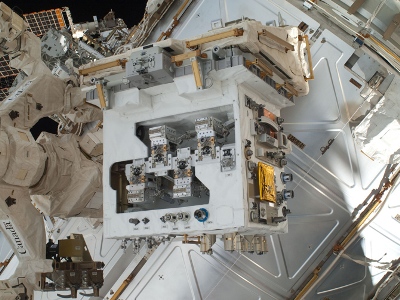The Robotic Refuelling Mission (RRM) will soon be transported to a permanent location by the International Space Station (ISS) on the ExPress Logistics Carrier-4. NASA and the Canadian Space Agency have come together to design the RRM, which represents the technologies, tools and methods that are needed for robotically servicing satellites.
The testing operations that have been going on for two years now are expected to yield results that minimise the risks in satellite servicing and create ground for future robotic service missions that will be associated with the repair and repositioning of the satellites in orbits.
 The Robotic Refueling Mission module, installed on its temporary platform on the International Space Station’s Dextre robot. RRM will demonstrate robotic servicing technology and lay the foundation for future missions. Credit: NASA
The Robotic Refueling Mission module, installed on its temporary platform on the International Space Station’s Dextre robot. RRM will demonstrate robotic servicing technology and lay the foundation for future missions. Credit: NASA
The Dextre robot was used by the RRM for the first time for purposes other than station maintenance. The robot was used for research purposes by looking into the requirements for robotic servicing of spacecraft that were not designed for refuelling and repair. The RRM module weighs 550 pounds roughly having dimensions of 33 x 43 x 45 in. and carries 0.45 gallons of ethanol for the purpose of demonstrating fluid transfer on orbit. In September NASA plans to place the module on the ExPress Logistics Carrier 4 (ELC-4) permanently with the help of the Canadarm2 robot. The required power, telemetry and command support to the RRM will be provided through the ELC-4 during the two-year experiment period that follows after the permanent placement.
Post transfer to ELC-4, operators will be releasing the launch locks on the four RRM tools, the wire cutter/blanket manipulation tool, the safety cap removal tool, the multifunction tool and the nozzle tool, to be used by Dextre later. A series of vision tasks for developing vision algorithms will follow and the first set of refuelling demonstrations are scheduled for January 2012. These demonstrations will validate whether orbit satellite repairs are feasible with currently available technology. NASA has had sufficient success with satellite repairs in the past. The Goddard, Johnson Space Center, Canadian Space agency and Marshall Space Flight Center will be controlling the RRM operations.